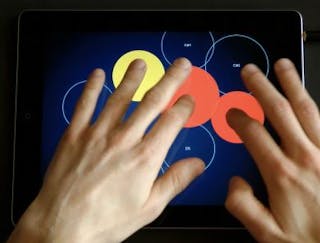Orphion: A Gestural Multi-Touch Instrument for the iPad

Researchers: Jamie Bullock and Sebastian Trump
Background
Senior Conservatoire Researcher, Jamie Bullock and Professor at Nuremberg University of Music, Sebastian Trump have carried out a research study which evaluates the design and concept of a new digital musical instrument app. This interactive app is named ‘Orphion’ and has been created especially for the Apple iPad, for music enthusiasts. The motivation to create this app was to develop a DMI (digital musical instrument) that had clearly mapped input gestures with distinctive tonal sound production. Their aim was to create an interface that felt natural to an acoustic musician e.g. a drummer.
The key focus on this app is to address the main problems that occur in the use of the app, particularly haptic feedback, which is the way that touch and sensations are used in a design interface to provide information to a user. A track pad interface was used to control the physical modeling and six players were used as testers on the prototype to provide feedback on the way it worked and how they could improve it. This meant that they could receive feedback orally and from touch data from the track pad.
Aims
The researchers aimed to ensure that their app matched up to their requirements:
- Encourage and allow virtuosity and expression
- To have an ergonomic design
- To ensure trace-ability for the public
- Guaranteed predictability for the player
- Primary visual feedback and Secondary audible feedback
- To make 'Orphion' affordable and widely available.
Results
After reviewing the constraints of haptic capability, the music play-ability, maintaining a natural feel, and technicalities it was decided that drum and string instruments would be the most suitable instruments to model the app on. They found that visually the app was simple and easy to use and different pads allowed for alternative musical genres.
Once the app was released to the app store they gathered additional feedback from reviews, with a rating of 4.5 out of 5 from 822 reviewers. They found that the majority of language used was positive and related to music which meant that they reached their goal of creating an instrument. Results also showed that it was suitable for a variety of different musicians however it’s challenging to use it to play written music.